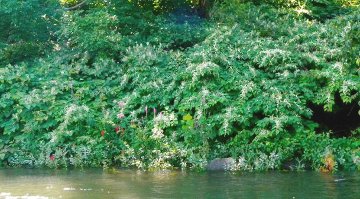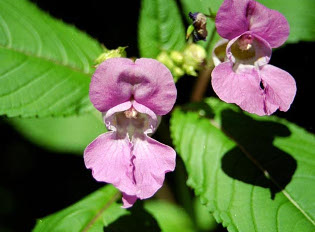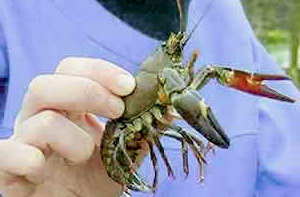Invasive species taking over
Article Index
WHILE we were out cruising our boat, enjoying the experience even if the weather was at times very changeable, there was however one very disturbing aspect that I have noticed more and more over the last few years, writes Mick Fitzgibbons.
Certainly one that seems to have taken off big style since last year. That is the amount of Japanese Knotweed. It seems to be everywhere you look.
 The rivers and canals are known to be providing a super-highway for the spread of this particular problem species. It is listed by the World Conservation Union as one of the world's 100 worst invasive species. The invasive root system and strong growth can damage concrete foundations and flood defences. It can also reduce the capacity of channels within flood defences to carry water.
The rivers and canals are known to be providing a super-highway for the spread of this particular problem species. It is listed by the World Conservation Union as one of the world's 100 worst invasive species. The invasive root system and strong growth can damage concrete foundations and flood defences. It can also reduce the capacity of channels within flood defences to carry water.
 More prolific
More prolific
Then as I started to take more than a passing interest, the more Himalayan Balsam (pictured) and Orange Balsam I came across. Seemingly the balsam is almost if not more prolific than the Knotweed. Himalayan Balsam is now widely established in the British Isles and is able to out compete our native plants. Adding to the mix is Buddleia that seemingly can root in the tiniest cracks and spaces along the banks of the inland waterways.
 This time while out I have seen several plots of Giant Hogweed. The sap of giant hogweed causes phytophotodermatitis in humans, resulting in chemical burns and blisters, (pictured) with long lasting scars and if it comes in contact with eyes, it can cause blindness. Giant Hogweed is highly invasive and has spread throughout the whole of Great Britain, primarily favouring canal and river banks. The Wildlife and Countryside Act 1981 lists over 30 problem plants including Japanese Knotweed and Giant Hogweed.
This time while out I have seen several plots of Giant Hogweed. The sap of giant hogweed causes phytophotodermatitis in humans, resulting in chemical burns and blisters, (pictured) with long lasting scars and if it comes in contact with eyes, it can cause blindness. Giant Hogweed is highly invasive and has spread throughout the whole of Great Britain, primarily favouring canal and river banks. The Wildlife and Countryside Act 1981 lists over 30 problem plants including Japanese Knotweed and Giant Hogweed.
Lip service
Call me old and cynical, but I think that CaRT's idea the 'Great Nature Watch' is a bit of lip service that is intended to placate the prospective punters. So, you might think with CaRT getting all 'touchy feely' over ecological and environmental issues, the invasive stuff would be high on the agenda, if only for protecting hundreds of miles of waterways habitat. You might think that getting rid of the invasive species was important, much more important than concentrating on cuddly furry voles. But then the cute furry little critters will help with the dash for the punters cash, (fleeced by a furry friend) much more than an appeal for money to combat Knotweed.
There is one huge problem looming on the horizon. Getting rid of Knotweed is an expensive operation. Land owners are now more than ever beginning to realise that an infestation of Knotweed can dramatically reduce land values and significantly raise development costs. The longer it is left un-remedied the more expensive it becomes.
Not an offence
However, as stated in the Environment Agency Knotweed Code of Practice "It is not an offence to have Knotweed on your land". It is generally thought that house gardens do not come within the definition of wild. However, canals and rivers certainly do. Under the Environmental Protection Act 1990 all Knotweed material (and soil containing Knotweed) is classed as controlled waste and must be disposed of at a licensed landfill site under strict codes of practice.
There are also powers under the Town and Country Planning Act which empower local authorities to require landowners to treat the land if it detracts from local amenities and that could include situations where Knotweed is present on the land. The Town and Country Planning Act is often used by local planning authorities by way of planning conditions to force developers to treat sites infested with Knotweed. These and other statutory material now giving rise to potential criminal prosecutions.
Legal action
Given the underground complexity of Knotweed rhizome it is almost certainly going to be the case that a landowner will need to require his neighbour to effectively treat Knotweed on the neighbour's land in order to abate the nuisance and solve the problem. In the event of a neighbour failing to cooperate a legal action may be commenced seeking various remedies including damages equating to the cost of treatment and possibly diminution in value of his land and injunctions enforcing the neighbour to carry out specific methods of treatment. Indeed, the granting of injunctions (which is a discretionary remedy) is generally the appropriate remedy. In encroachment cases no actual damage needs to be proved in order to bring a claim.
Where Knotweed spreads from land A to land B and then to land C, although the owner of land B may be liable to the owner of land C. The landowner may be able to claim an indemnity from the owner of land A. The landowner can also be liable for allowing nuisance to continue even if he did not create it. The landowner will be responsible for continuing damage and given the likely claim against him for an injunction, the cost of its treatment.
As is always the case, prevention is better than cure. Any landowner should therefore seek immediate advice from specialists as soon as they are aware or made aware of the presence of Knotweed to avoid what could turn into an extremely costly and complicated piece of litigation.
Taking CaRT to court
Solid structures such as concrete and tarmac are no barrier to its growth and the weed also creates a risk of flooding if leaves clog waterways. As the Knotweed takes a more significant hold along many watercourses and the adjoining land much of which is now owned by CaRT, people with adjoining properties that have been or are at risk of being infested by Knotweed will no doubt be taking CaRT to court if the infestations remain un-remedied and begin to spread onto their property. As one solicitor stated, Japanese Knotweed is going to be a good replacement for whiplash injuries in no win no fee litigation.
The use of smartphone apps such as Plant Tracker is already adding photographic sightings and GPS locations of existing infestations into the Plant Tracker database. This could be used to provide evidence of the locations of pre-existing infestations for landowners. I have been recording and reporting, for two years now, the waterways locations of Giant Hogweed and Knotweed infestations while cruising the waterways.
Go to planttracker.naturelocator.org or download the app directly onto your smartphone from Google Play.
Tens of millions
There are no definitive industry wide figures for just how much the Japanese Knotweed plant costs to eradicate. But even on relatively small building sites the cost of control can run into hundreds of thousands of pounds. Developers are also often required to tackle the plant in order to maintain their legal obligations under the Wildlife and Countryside Act 1981. The annual cost across Britain is likely to be many tens of millions. The cost to eradicate Japanese Knotweed in Britain using conventional methods was estimated a couple of years ago to be £1.56 billion.
 But there are other invasive species in our waterways. The American Mink was brought to Great Britain in the early 20th century for fur farming. Then they became established in the wild after escapes and deliberate releases. They are opportunistic predators and will take a wide variety of prey, often killing more than they require for food. Among their prey is the native and protected Water Vole. Since the introduction of mink, Water Voles have rapidly declined. Recent surveys have found that Water Vole sites have diminished by as much as 94% and are one of the most rapid and serious declines of any British wild mammal during the 20th century.
But there are other invasive species in our waterways. The American Mink was brought to Great Britain in the early 20th century for fur farming. Then they became established in the wild after escapes and deliberate releases. They are opportunistic predators and will take a wide variety of prey, often killing more than they require for food. Among their prey is the native and protected Water Vole. Since the introduction of mink, Water Voles have rapidly declined. Recent surveys have found that Water Vole sites have diminished by as much as 94% and are one of the most rapid and serious declines of any British wild mammal during the 20th century.
Creating areas to reintroduce water voles does little more than add an additional item to the menu for mink! The problem has been exacerbated by habitat changes in the Water Vole's natural habitat. Invasive non-native species are estimated to cost well over £2 billion a year in Great Britain.
CAVEAT: We must not think that all non-native species are bad. Indeed it is only a minority that have serious negative impacts on our native British species, our health or our economy.
Invasive species
Many invasive species are in and around our waterways. Zebra Mussel, Signal Crayfish, Mink, Chinese Mitten Crab and American Bullfrog to name a few can have a damaging effect on the infrastructure.
 Chinese Mitten Crab. Now established in the Rivers Thames, Medway and Ouse and recorded from several sites throughout England and Wales, including the rivers Tyne, Tamar and Dee and Southfields Reservoir near Castleford, Yorkshire, this is a voracious predator that will consume a range of invertebrate species and the eggs of fish leading to competition with native species and impacting invertebrate and fish populations. It will burrow into river banks, increasing erosion and river turbidity, and causing bank collapse.
Chinese Mitten Crab. Now established in the Rivers Thames, Medway and Ouse and recorded from several sites throughout England and Wales, including the rivers Tyne, Tamar and Dee and Southfields Reservoir near Castleford, Yorkshire, this is a voracious predator that will consume a range of invertebrate species and the eggs of fish leading to competition with native species and impacting invertebrate and fish populations. It will burrow into river banks, increasing erosion and river turbidity, and causing bank collapse.
 American Bullfrog. The bullfrog is one of the most harmful invasive non-native species. It both competes with and eats native amphibians, and carries a disease that has contributed to worldwide amphibian decline and to several global extinctions. It occupies any type of still or slowly moving water, especially where aquatic and bank vegetation are abundant. Now established in the UK.
American Bullfrog. The bullfrog is one of the most harmful invasive non-native species. It both competes with and eats native amphibians, and carries a disease that has contributed to worldwide amphibian decline and to several global extinctions. It occupies any type of still or slowly moving water, especially where aquatic and bank vegetation are abundant. Now established in the UK.
 American Mink. The mink is a semi-aquatic, generalist and opportunist predator with a variable diet that includes aquatic, semi-aquatic and terrestrial prey. Mink are generalist predators of animals such as domestic ducks and poultry, game birds and fish. They take eggs and chicks. They have been linked to the decrease of water voles in Great Britain and cause damage to fisheries. Mink occupy both freshwater and saltwater habitats. Mink habitually follow all kinds of waterways and watercourses but will cross other habitats.
American Mink. The mink is a semi-aquatic, generalist and opportunist predator with a variable diet that includes aquatic, semi-aquatic and terrestrial prey. Mink are generalist predators of animals such as domestic ducks and poultry, game birds and fish. They take eggs and chicks. They have been linked to the decrease of water voles in Great Britain and cause damage to fisheries. Mink occupy both freshwater and saltwater habitats. Mink habitually follow all kinds of waterways and watercourses but will cross other habitats.
 Signal Crayfish. The signal crayfish is much larger than the native white-clawed crayfish. It is well established in England and Wales. The signal crayfish is driving the native white-clawed crayfish towards extinction and causing declines in diversity and richness of aquatic communities. Burrowing by crayfish can cause erosion of riverbanks and destabilise structures built at the edges of rivers. Signal crayfish are found in streams, canals, rivers, lakes and ponds, and are also able to survive in brackish water.
Signal Crayfish. The signal crayfish is much larger than the native white-clawed crayfish. It is well established in England and Wales. The signal crayfish is driving the native white-clawed crayfish towards extinction and causing declines in diversity and richness of aquatic communities. Burrowing by crayfish can cause erosion of riverbanks and destabilise structures built at the edges of rivers. Signal crayfish are found in streams, canals, rivers, lakes and ponds, and are also able to survive in brackish water.
 Zebra Mussel. Due to its filtering capacity and ability to produce dense populations, it can significantly reduce native biodiversity, and alter whole freshwater ecosystems. It is also a nuisance and economic problem when growing in pipes of water treatment plants. It forms dense colonies and can be found in both flowing and standing water bodies.
Zebra Mussel. Due to its filtering capacity and ability to produce dense populations, it can significantly reduce native biodiversity, and alter whole freshwater ecosystems. It is also a nuisance and economic problem when growing in pipes of water treatment plants. It forms dense colonies and can be found in both flowing and standing water bodies.
The GB Non-Native Species Secretariat is the authoritative source of information for all invasive, non-native species information in Britain. They have excellent information guides on all the main species, image galleries, notices of events etc. They also act as a good portal to Local Action Groups (LAGs) which are always looking for more help to tackle invasive species.
